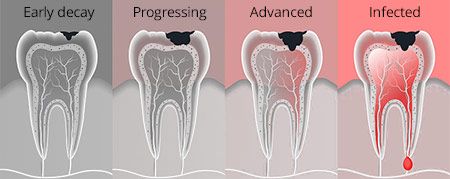Tooth decay commonly leads to cavities or dental caries. Broadway Family Dental offers tooth decay treatment to repair your smile. Decay, indirectly caused by food left between teeth, eats away at your enamel, creating a hole in a tooth. You can’t cure tooth decay, but you can prevent it with regular brushing, flossing, and visits to your dentist.
What is Tooth Decay?

When plaque builds up in your mouth, it breaks down your teeth’ enamel, leading to tooth decay. Plaque is more common among children and young adults, but everyone’s at risk. If left untreated, tooth decay can result in tooth pain and more serious infections, including tooth loss.
The National Institute of Dental and Craniofacial Research estimates that more than 90 percent of adults aged 20 to 64 have had some tooth decay in their lives. And the Centers for Disease Control reports that almost 30 percent of Americans have untreated tooth decay.
Read more: How Long Should a Dental Filling Last?
What Are the Symptoms of Tooth Decay?
The first sign of tooth decay is brown or white spots on your teeth. If the condition progresses, cavities, or so called holes, develop on the surface of the teeth. Tooth decay can also damage the nerves in the roots and teeth if the deep layers of the teeth get affected. This will lead to tooth sensitivity. Cavity symptoms may vary, depending on the size and location of the affected tooth.
Some of the most distinguishing tooth decay symptoms are:
- A noticeable hole in a tooth
- A toothache ranging from mild to sharp
- Sensitivity when consuming something hot, cold, or very sweet
- Discolored or stained tooth
- Pain when chewing or biting down
What Are the Causes?
A combination of three things normally causes tooth decay. These include poor oral hygiene, consuming a lot of sugar, and plaque. A hard enamel coating protects your teeth. Starches, sugars, and sticky foods promote tooth decay because they adhere to the enamel and create acids. These acids encourage bacteria, which destroy the tooth’s hard, outer enamel.
Once past the enamel, bacteria and acid can more easily reach the dentin. Dentin is softer than enamel and less resistant to acid. If left untreated, the bacteria and acid spread, making another hole in a tooth — the same or a different tooth — progressing to the pulp. The pulp, which contains nerves and blood vessels, can become swollen and infected from the bacteria, causing pain and discomfort.
Google ReviewsI would definitely recommend this office. I had cavities, tooth decay & gum disease due to the type cancer I had. I went to a previous dentist who did nonsense on my mouth then I came in contact with this office. I don’t regret it. A lot of work had to be done on my mouth. I spent 1 year taking care of the gum disease , getting my tooth fixed & I must say they are the absolute best in what they do.
Verified Patient
How To Prevent Tooth Decay?
While you can’t cure tooth decay, good oral hygiene habits can help prevent the disease. You can lower the risk by brushing your teeth on a regular basis with fluoride toothpaste. It will help make your enamel stronger.
Regular brushing will help remove plaque, which contains harmful acid and bacteria. As a leading tooth decay treatment specialist in Bushwick, Brooklyn, NY, Dr. Ella Dekhtyar, recommends brushing the teeth at least twice a day after each meal.
Foods that you consume also matter. Limit your intake of sugar to lower the risk of tooth decay. Fruit juices, ketchup, candy, and soft drinks also contain a lot of sugar, hence, should be avoided. Regular visits to your local dentist will also help you to protect your teeth as any tooth decay can be detected early.
Some easy practices to avoid getting a hole in a tooth include:
- Brush with fluoride toothpaste after each meal or at least twice a day
- Floss between your teeth at least daily
- Visit your dentist regularly for professional teeth cleanings and regular oral exams — your family dentist may recommend a fluoride mouth rinse or periodic fluoride treatments
- Consider dental sealants, protective plastic coatings applied to the surface of back teeth, which typically last five to ten years, but still need to be checked regularly
- Practice healthy eating habits by not snacking throughout the day and by avoiding sweet, starchy, or sticky foods — replace them with fresh fruits and vegetables
- Avoid bedtime infant feeding because the beverages remain on your baby’s teeth for hours while he sleeps, feeding decay-causing bacteria
Read more: Does Getting A Cavity Filled Hurt?
What Are the Various Types of Tooth Decay?
There are three types of tooth decay: smooth surface, pit and fissure, and root. A tooth decay specialist can determine which of the three types of tooth decay or cavities you have:
- Smooth Surface Cavities. These tooth cavities occur on the flat exterior surface of your teeth.
- Pit and Fissure Cavities. These cavities are found on the chewing surfaces of your teeth, usually in the back of your mouth.
- Root Cavities. These tooth cavities appear on the surface of your teeth. They most commonly occur among older adults who are more likely to have receding gums and other gum disorders.
Your family dentist can detect and determine the type of tooth decay by:
- Inquiring about your tooth pain and sensitivity
- Examining and probing your mouth and teeth
- Looking at dental X-rays, which can show the extent of tooth decay
Read more: How Long Does a Root Canal Take
What Are My Dental Caries Treatment Options?
Apart from various conventional ways of treating tooth decay, there are a number of newest procedures. Some of these procedures no longer involve a drill. For instance, a technique called “caries infiltration” can be utilized to treat tooth decay in its early stages. This method entails plastic to harden the tooth.
Your New York family dentist also offers a variety of traditional tooth decay treatments in Bushwickm Brooklyn, NY, such as:
- Fluoride treatments. If tooth decay is in a very early stage, a fluoride treatment may help restore your tooth’s enamel.
- Fillings. A filling is your dentist’s main tooth decay treatment option when the decay has progressed beyond the earliest stage.
- Crowns. For extensive tooth decay, you may need a dental crown. A crown is a custom-fitted cap that replaces your tooth’s entire natural crown.
- Root canals. If the decay has reached the pulp of your tooth, you may need a
root canal procedure. The dentist removes the decayed tooth pulp and replaces it. - Tooth extractions. When a tooth is so severely decayed that it can’t be restored, then it must be removed.
By practicing good oral hygiene habits and keeping your regularly scheduled dental checkups, you can lower your odds of getting tooth decay. But if you ever have troubling cavity symptoms, the sooner you seek care, the better your chances of reversing the earliest stages of tooth decay and preventing its progression.
Do you have any questions for dentist Dr. Ella Dekhtyar about tooth decay treatment? Would you like to schedule an appointment with the best dentist in Bushwick, Brooklyn, Dr. Dekhtyar of Broadway Family Dentistry? Please contact our office for a consultation.

Dr. Ella Dekhtyar is an ABGD-certified cosmetic and family dentist who strives to provide the best and most appropriate dental care using the latest cutting-edge technology and treatment. Dr. Dekhtyar has more than 20 years of experience creating beautiful and healthy smiles, backed by receiving multiple awards, including America’s Best Dentist and New York Magazine Best Dentists in 2010 & 2012, and her collaboration with prominent media outlets.
Recognized as one of the most highly regarded dentists in the Bushwick and Bedford-Stuyvesant community, Dr. Dekhtyar operates in several languages, including English, Spanish, as well as Russian, and provides highly praised aesthetic and functional results in a welcoming and relaxing environment.
More about Dr. Dekhtyar